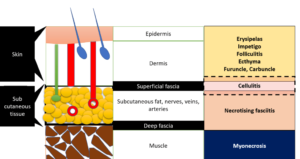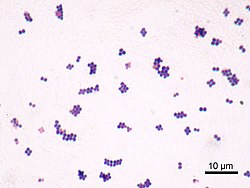Norovirus
Epidemiology Norovirus is the most common cause of epidemic gastroenteritis worldwide. In the UK, norovirus outbreak is usually seen in the winter months. The virus Norovirus is a small non-enveloped RNA virus of the caliciviridae family. It has ten genogroups, but I, II and IV are primarily implicated in human infection. Genogroup II is most […]
Neurobrucellosis
Brucellosis is a zoonotic infection transmitted to humans from animals (cattle, goats, sheep) via The UK is a non-endemic country. Most brucella cases in the UK are imported cases with links to Mediterranean or Middle Eastern countries. However, Brucella is also endemic in Central Asia, China, South Asia, sub-Saharan Africa, and some parts of Middle and […]
Necrotising fasciitis
Necrotising fasciitis (NF): It is an infection of the subcutaneous tissue/fat and fascia of the skin. It spreads rapidly along the fascial plane. Muscles are less commonly affected/ affected later in the disease due to better blood supply. Classification Types Organism Note Type 1 – polymicrobial/synergistic Aerobic and anaerobic bacteria Often derived from gut/bowel Type […]
MRSA guideline – HIS and IPS guideline
Universal or targeted screening Rescreening Test Staff screening Decolonisation In patients with eczema, dermatitis, or skin conditions – an attempt should be made to treat underlying skin conditions. A dermatology consultant could be consulted. Alternatives are – Oilatum bath additive or Oilatum plus (with added benzalkonium chloride 6% and triclosan 2%).Mupirocin prolonged or repeated use […]
Microbiology for medical students / Foundation Doctors
Introduction Microbiology can be a daunting subject for medical students and junior doctors alike to approach. Confronted with masses of information and bacteria names more suited to winning Scrabble competitions, it’s often difficult to know where to start! However, acquiring a good understanding of microbiology can be life-saving for your patients, so it is well […]
Leptospira spp.
This is from a presentation. The pictures were my slides. Feel free to download them if you wish. Leptospirosis, a zoonosis, is caused by a pathogenic Spirochaeta of the genus Leptospira.The name is derived from the Greek leptos (thin) and the Latin spira (coiled). Leptospirosis is a multisystem disease first described by Albert Weil in […]
Kingella spp.
Bacteria: Fastidious gram-negative coccobacilli that appear in pairs or short chains.Commensal of the mouth and upper respiratory tract.The genus Kingela have species like – K. kingae, K. denitrificans, Kingella negevensis, K. oralis etc. Identification: It appears as pairs/short chains of plump bacilli (or coccobacilli) with tapered ends.Capnophilic and facultatively anaerobic, nonmotile, non-spore-forming.Beta-haemolytic colonies on blood agar often produce marked pitting […]


